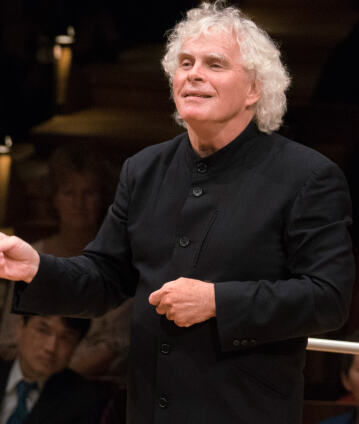Simon Rattle conducts “Petrushka”

On their 2017 Asian tour, the Berliner Philharmoniker and Simon Rattle are presenting a Russian programme that underlines the range of qualities of the orchestra. Stravinsky’s Petrushka, for example, requires intense colours and concentrated energy, while in Rachmaninov’s Third Symphony, it is warmth and airy spaciousness that count. There is also a new work by the Korean composer Unsuk Chin. Before the tour began, the musicians presented the programme in the Berlin Philharmonie.
Igor Stravinsky is one of Sir Simon Rattle’s favourite composers. Since the beginning of his career, the Russian’s works have been an important component of his repertoire. He has also regularly included his compositions in the programmes of his concerts as chief conductor of the Berliner Philharmoniker. On this occasion, he presents Petrushka, a piece that Stravinsky wrote immediately after the enormous success of his first ballet The Firebird. While working on what was originally conceived as a concert piece for piano and orchestra, “a distinct picture” came to him “of a puppet suddenly endowed with life, and exasperating the patience of the orchestra with diabolical cascades of arpeggios”.
Sergei Diaghilev, the impresario of the Ballets Russes, recognised at once the potential in the music for a successful dance project and encouraged Stravinsky to turn it into a ballet. Petrushka takes us to the colourful, bustling world of a Russian fair. Against this background, the story unfolds of the ugly, stiff puppet Petrushka’s unhappy love for a beautiful ballerina who, in turn, has fallen for a handsome Moor. Stravinsky created very vivid and gestural music, making use of a montage technique in which he combines set pieces from Russian folk songs, dances and popular music plus striking motifs and melodic units into an individual, dramatic tonal language.
Rachmaninov’s Third Symphony is also rooted in the Russian musical tradition – albeit in a different way. With its wistful, mournful themes, its dance rhythms and numerous musical allusions, the work is considered the summation of late-Romantic Russian symphonic music. Rachmaninov wrote his third and last symphony in 1935-1936, nearly 30 years after his second. At that time, he had been living for nearly 20 years in the United States where he had emigrated at the outbreak of the Russian Revolution, and where he had built a phenomenal career as a pianist. The composer reported that public and press reacted “peevishly” to the symphony. “I am personally convinced that this is a good work,” he said self-assuredly. Between the compositions of the two Russians, Simon Rattle has programmed a musical “tapas”: the world premiere of a new short piece by the Berlin-based South Korean composer Unsuk Chin, part of a series which the Philharmonic’s chief conductor has commissioned from major contemporary composers.
© 2017 Berlin Phil Media GmbH
Related interviews
Artists
Our recommendations
- Beethoven and Mozart with Simon Rattle and Mitsuko Uchida at the Easter Festival
- Simon Rattle conducts Messiaen’s “Turangalîla-Symphonie”
- Paul Whiteman’s greatest hits with Simon Rattle and Max Raabe
- Season opening 2012: Simon Rattle and Yefim Bronfman
- Mozart’s “Magic Flute” from Baden-Baden
- Simon Rattle conducts Beethoven’s Symphonies Nos. 1 and 3